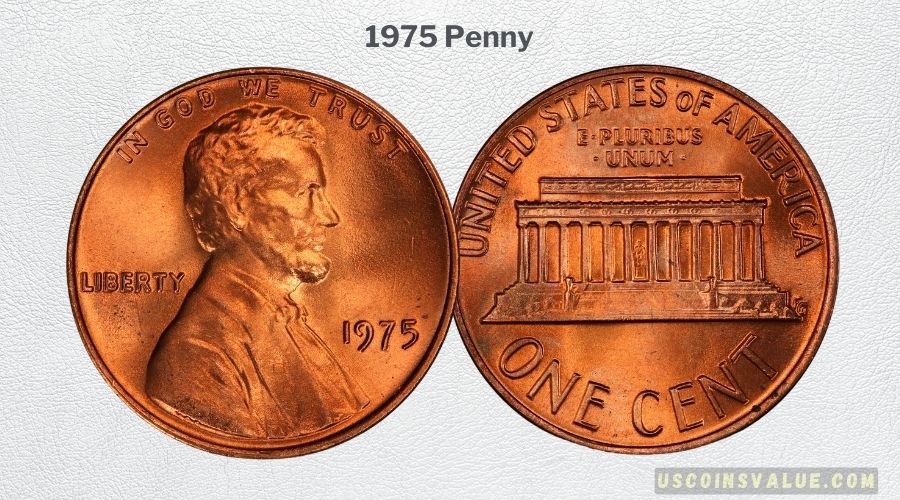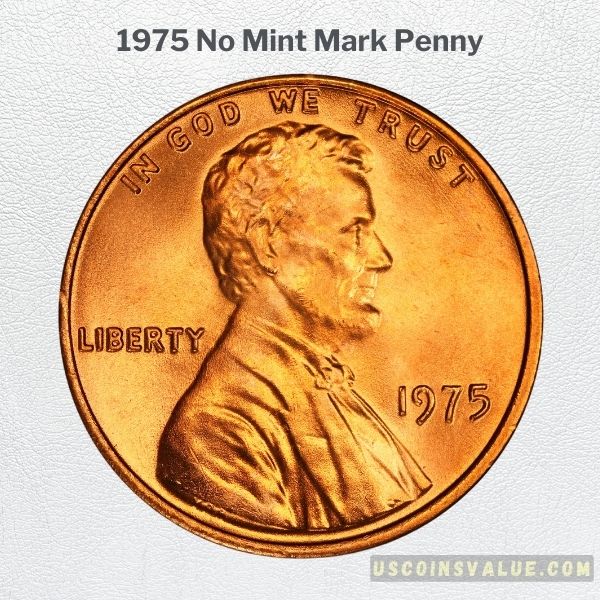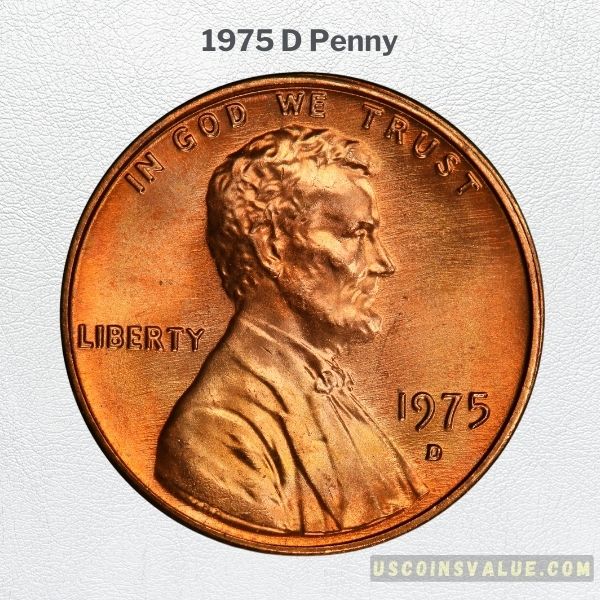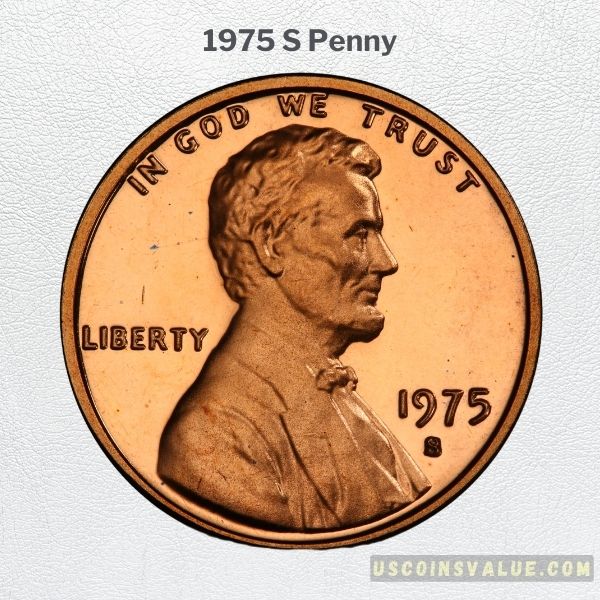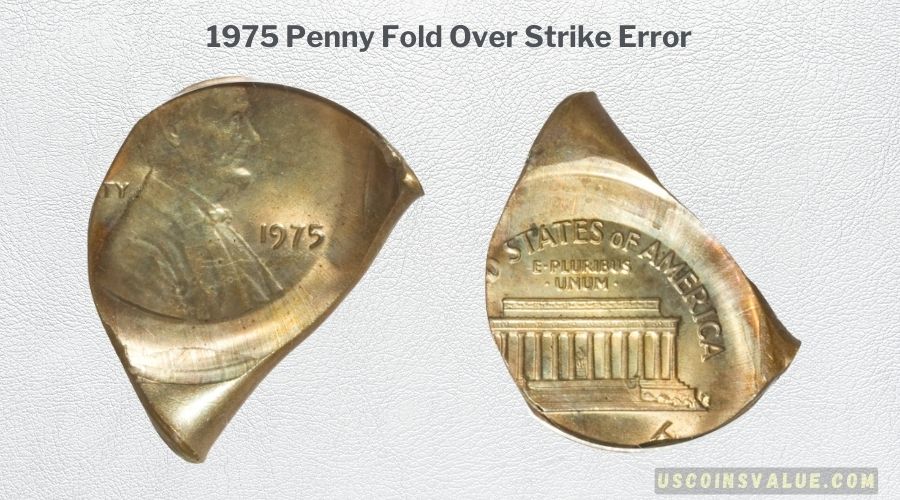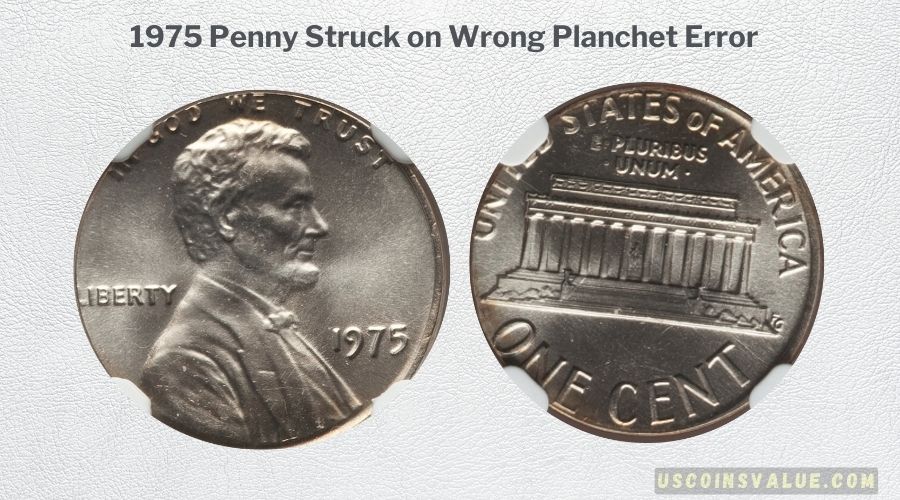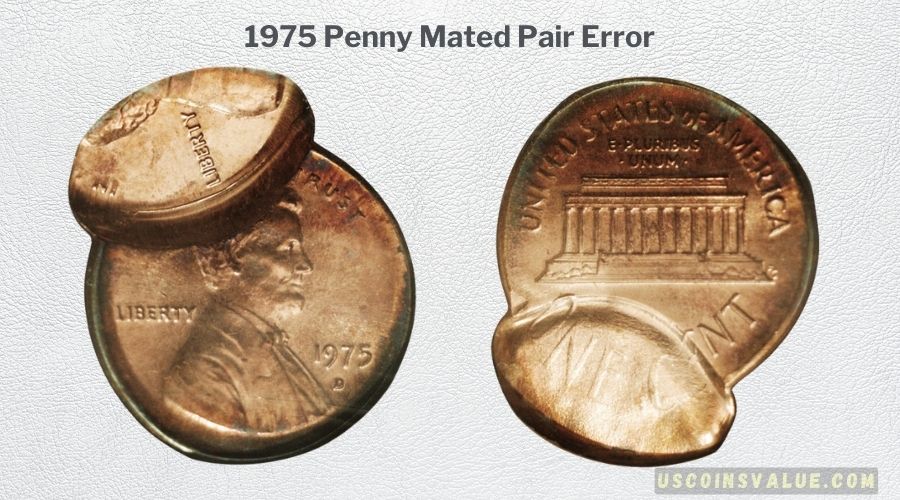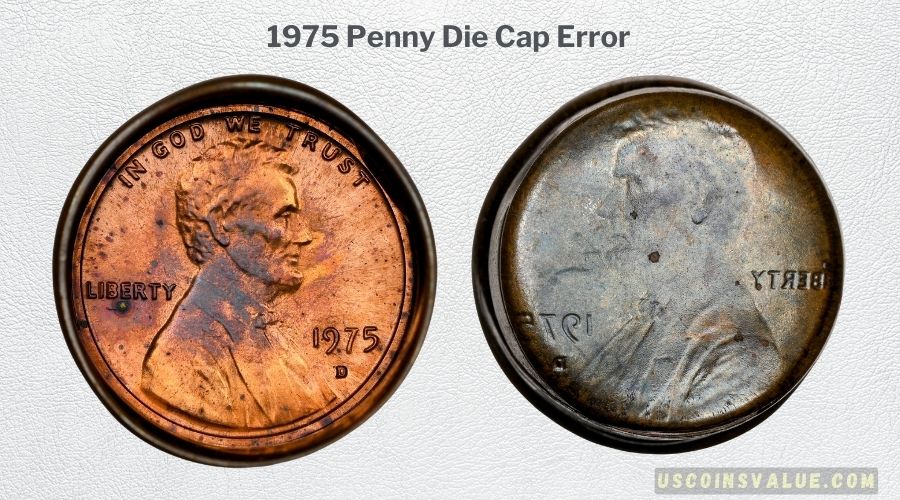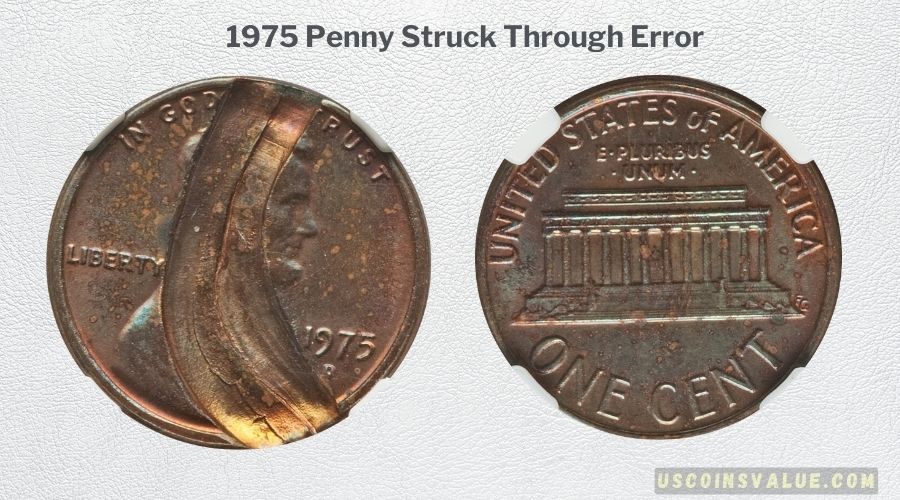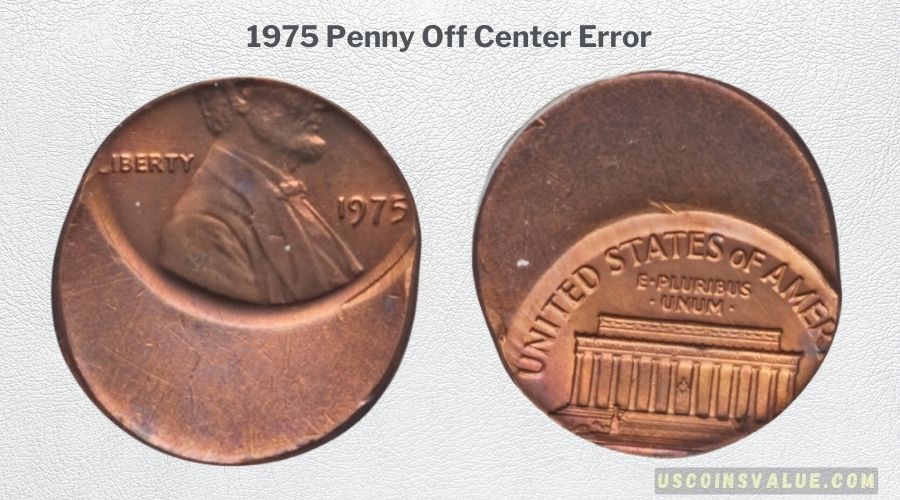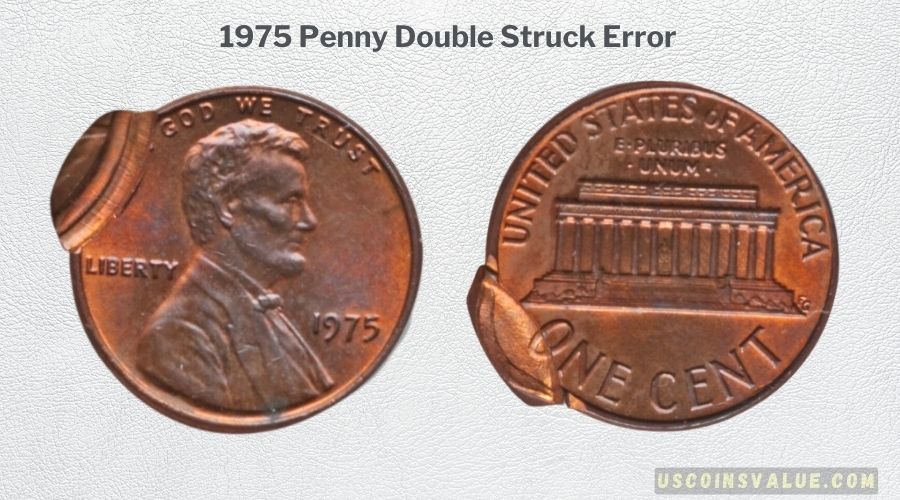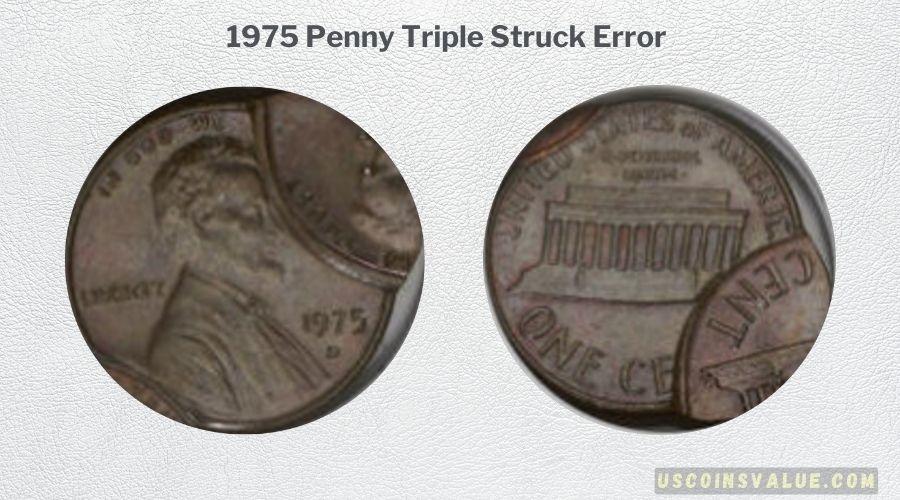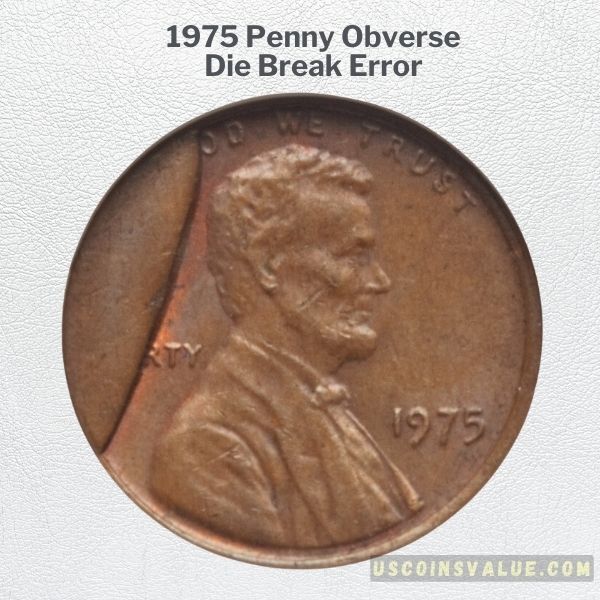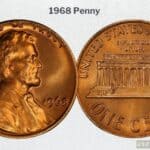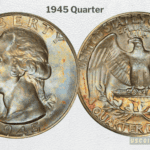The highest recorded sale of a 1975 penny was a remarkable MS68 RD coin that fetched $9,000 at a Heritage Auction in 2018.
Nevertheless, the most valuable 1975 penny is the PR70-proof penny, and it holds a unique distinction as only one of its kind is known to exist, commanding a value of $15,000.
So, when asking how much is a 1975 penny worth, here are the three considerations to keep in mind:
- The most valuable 1975 pennies are in the most pristine condition. MS68 or higher is worth $9000 – $10,500.
- Proof pennies graded PR70 are the rarest, valued at $15,000.
- Mint errors drastically increase the value of these coins, with the rarest errors costing $200 – $1,500. Minor common errors are worth $50 – $150.
Here, we’ll explore the value of 1975 pennies, dive into their rarity, the impact of mint errors, and the different mint varieties that make each 1975 penny unique. Whether you’re a newbie or a seasoned collector, you’ll find valuable insights on these unassuming copper-clad pennies.
1975 Penny Value Summary
Below is the 1975 penny value chart, arranged based on grade condition and strike:
| 1975 Penny and Coin Grade | 1975 No Mint Mark Penny (MS) | 1975 D Penny (MS) | 1975 S Penny Proof (PR) |
| 60 | N/A | $0.10 | $1.85 |
| 61 | N/A | $0.25 | $1.85 |
| 62 | N/A | $0.50 | $2 |
| 63 | $3 | $1 – $7 | $2 – $4 |
| 64 | $3 – $8 | $2- $12 | $3 – $4 |
| 65 | $8 – $16 | $3 – $16 | $5 – $6 |
| 66 | $15 – $35 | $5- $47 | $6- $9 |
| 67 | $140 | $8 – $185 | $8 – $14 |
| 68 | $10,500 | $10,000 | $15 – $19 |
| 69 | N/A | N/A | $35 – $55 |
| 70 | N/A | N/A | $15,000 |
Note:
- The N/A in columns without a price guide does not mean the coins are rare. Instead, it shows there isn’t enough data or coins to publish an average price estimate.
- The grades (60 – 70) represent the particular coin’s grading prefix, i.e., MS60-MS70 for Regular Strike coins and PR60-PR70 for Proof pennies.
1975 Lincoln Penny Background
1975 pennies are part of the Lincoln Cent, Memorial Reverse Series (Type 3) of coins that were produced from 1959 to 1982.
In 1959, the U.S. Mint changed the reverse design to commemorate the 50th anniversary of the Lincoln Cent. The design changed from the Wheat Ears/Wheat Stalks reverse to that of the Lincoln Memorial. Some coin dealers and collectors refer to this iteration as the Lincoln Memorial Series.
Another distinctive fact of this series is its composition. 1972 pennies, and Lincoln Memorial pennies in general, were primarily made of copper with a metal composition of 95% Copper, 5% Zinc & Tin, hence the name copper pennies. This composition was changed in 1982 when the U.S. Mint switched to copper-plated zinc.
The 1972 pennies were made in the three U.S. mints – Philadelphia (P), Denver (D), and San Francisco (S). Below are the mint varieties:
- 1975 No Mint Mark Penny – made in Philadelphia (P) but like other coins made in this mint, these pennies do not have mint marks.
- 1975 D Penny – made in Denver and includes the ‘D’ mint mark.
- 1975 S Penny – these are Proof strike coins, made specifically for collectors and numismatic purposes. They feature an ‘S’ mint mark denoting the San Francisco mint.
Here is a quick summary of the coin’s mintage and metal composition:
| Coins | Mint | Total Mintage | Metal Composition |
| 1975 No Mint Mark Pennies | Philadelphia | 5,451,476,142 | 95% Copper, 5% Zinc & Tin |
| 1975 D Pennies | Denver | 4,505,245,300 | 95% Copper, 5% Zinc & Tin |
| 1975 S Pennies (Proof) | San Francisco | 2,845,450 | 95% Copper, 5% Zinc & Tin |
Other features you may find interesting about these pennies:
- Obverse (heads) design: Features Abraham Lincoln’s bust facing the right.
- Reverse (tails) design: Features the Lincoln Memorial building and a tiny figure of Lincoln at the center of the Memorial.
- Weight: 3.11 grams
- Diameter: 19 millimeters
- Thickness: 1.52 millimeters
- Edge: Smooth/Plain
- Face Value: $0.01
- Melt Value: $0.0245
What Is A 1975 Penny Worth?
The 1975 penny, in general, is not considered exceptionally valuable, especially when compared to older or rarer coins. However, two specific factors can make 1975 pennies worth money, the number one factor being the coin’s grade:
1. Coin Grade
The Sheldon’s scale is the industry standard for grading coins like the 1981 penny. The scale is from 1 – 70 where a coin’s condition is ranked between a number from 1 to 70 with a prefix (MS or PR) that shows if it’s a Regular Strike coin (MS) or a Proof Coin (PR).
When looking for 1975 pennies, you should focus on these two categories:
- MS (60 – 70) – stands for Mint State and is used to show the condition of circulation coins from grades 60 to 70.
- PF (60 – 70) – stands for Proof and is used to show the grade of Proof uncirculated coins with the most pristine details.
A PR70 penny is a Proof (PR) coin with the highest possible grade. This is the most valuable 1975 penny, valued at $15,000. It is followed closely by the MS68 penny worth $9,000- $10,500 in the open market.
The higher the grade the better.
2. Mint Errors
Mint errors are differences in the coin’s appearance caused by mistakes that took place during the minting process. The rarer the mistake the more valuable the penny.
In the case of 1975 pennies, the rarest mint errors are ‘Fold Over Strike’, ‘Wrong Planchet’, and ‘Mated Pair’ errors. These errors can increase the value of a regular 1975 pennies from a few bucks to $200 – $1,500.
Common errors like die cracks and lamination errors cost the least, worth less than $100.
1975 Penny Value: By Type
Below is the value of each 1975 penny based on the three mint categories:
1. 1975 Penny No Mint Mark (1975-P Penny) Value
According to the USA Coin Book, the 1975 No Mint Mark Penny is worth $1.16 or more in grades above MS65.
Other resources like NGC and PCGS indicate their value at $8 – 16 in MS65. Coins in this grade have high-quality strikes, with original full luster, few contact flaws, and above-average eye appeal.
They are overall good-looking coins; however, collectors do not value them highly since they were minted in billions, and the only special coins are those in MS68 or higher.
Only four MS68 coins have been graded by PCGS, none by NGC. These are extremely rare grades of coins from the 1970s. MS69 and MS70 pennies are yet to be found.
If you are looking for the most profitable 1975 no mint mark pennies then you should only go for the MS68 grades.
Only one MS68 graded 1975 penny has ever been sold, for $9,000 in 2018 making it the highest auction record in the entire lineup. Below are other auction records for the Philadelphia pennies:
Historical auction records for the 1975 penny no mint mark:
| Grade | Price | Firm | Sale Date |
| MS68 RD | $9,000 | Heritage Auctions | 2018 |
| MS65 | $900 | Heritage Auctions | 2020 |
| MS67+ RD | $881.25 | Heritage Auctions | 2017 |
| MS67+ RD | $555 | eBay | 2023 |
| MS67+ RD | $493.50 | Heritage Auctions | 2016 |
2. 1975 D Penny Value
According to the USA Coin Book, the 1975 D Penny is worth $1.16 or more in grades above MS65. The melt value is $0.0247 but its intrinsic value increases with mint errors and greater condition.
The Denver cents are harder to find in MS68 grades since the Denver Mint didn’t produce the best quality strikes. These coins haven’t aged gracefully. PCGS only has one MS68-graded coin in their catalog, valued at $10,000.
MS67 coins are plenty with more than a couple of hundreds, all worth more than $140. Any penny below MS63 will fetch less than $10 and only higher if it features a rare mint error.
Historical auction records for the 1975-D penny:
| Grade | Price | Firm | Sale Date |
| MS67+ | $4,112.50 | Heritage Auctions | 2014 |
| MS67+ RD | $3,055 | Legend Rare Coin Auctions | 2019 |
| MS67+RD | $2,820 | Heritage Auctions | 2016 |
| MS67+RD | $780 | Heritage Auctions | 2019 |
| MS67 | $690 | Heritage Auctions | 2005 |
3. 1975 S Penny (Proof Coins)
Proof pennies do not usually cost a lot. The coins are made for specifically collectors, and sold in sealed packages to maintain their plush looks and detailed features. Therefore, only the highest PR70 grade is ever worth any money.
According to the USA Coin Book, the 1975 Proof pennies are worth $3.98 or more in grades PR65 or above. PR68 is worth $15, and $55 for PR69, while PR70 is valued at a whopping $15,000.
Please keep in mind that only one PR70 coin has ever been graded by PCGS and NGC. It is among the rarest 1975 pennies.
Another valuable factor is the uniqueness of the surface finish. Proof coins are rated from Red to Cameo to Deep Cameo.
Deep Cameo (DCAM) is the most pristine and what you should look for if you want the most valuable proof coin. They are extremely attractive with a frosted (Cameo) effect which is highly pronounced and stands out against the penny’s background. No other coin looks lustrous than the DCAM varieties.
Historical auction records for the 1975-S Proof penny:
| Grade | Price | Firm | Sale Date |
| PR69 DCAM | $1,150 | Heritage Auctions | 2002 |
| PR69 DCAM | $780 | Heritage Auctions | 2003 |
| PR69 DCAM | $500 | eBay | 2021 |
| PR69 DCAM | $471.50 | Heritage Auctions | 2002 |
| PR69 | $373.50 | Heritage Auctions | 2002 |
Most Valuable 1975 Penny Errors
Errors not only increase the value of the coin but also make the pennies more collectible among enthusiasts.
Each error has its own value and that value can change depending on the error severity or popularity. Below is the 1975 penny error list featuring some of the rarest and most valuable errors:
1. Fold Over Strike
The Fold Over Strike is the highest recorded sale of any 1975 penny error: MS65 for $1,495 in 2010.
A fold-over strike error occurs when a portion of the coin’s metal is folded over the edge during the striking process, creating a distinct crease on the coin.
2. Struck on Wrong Planchet Error
The error occurs when a coin is mistakenly struck on a planchet (the metal disc from which a coin is struck) intended for a different coin. The result of this is a coin that features a unique design & specifications that were intended for a different coin.
‘Wrong Planchet’ errors are the most common of all 1975 penny errors. The top two are ‘Struck on a 1C planchet’ and ‘Struck on a 10C planchet’ errors.
Struck on a 1C planchet errors sell for $200 – $400 at auctions. On the other hand, Struck on a 10C planchet is more valuable, with some selling for over $800 like this MS65 coin that was auctioned for $900.
3. Mated Pair
‘Mated Pair’ is a rare error that is typically valuable in any lineup of coins. In this case, a 1975 penny with this error refers to a coin that was struck alongside another coin, essentially becoming stuck (mated) during the minting process.
An example is this ‘Mated pair’ MS62 penny that sold for $747.50 on Heritage Auctions in 2010 or the MS66 grade sold for $373.75 in 2006.
In both cases, you have two consecutive 1975 pennies which were meant to be struck separately but due to production errors, they were placed together and mated with one single strike.
4. Die Cap Error
Die Cap errors happen when a coin is struck but remains stuck in the die, failing to eject properly. The stuck coin is then struck several times in its stuck position until it develops a cap-like shape before finally getting ejected.
The coin can get stuck in either the reverse or obverse design dies. For the 1975 pennies, die caps are common on the obverse side; for example this ‘Obverse deep die cap’ MS64 coin sold for $600 or this MS65 coin sold for $360 at Heritage.
5. Struck Through Error
These errors occur when foreign materials fall between the planchet and the die. Therefore, when the coin is struck, these materials are included in-between creating an impression or marks on the coin’s surface.
Examples include:
- ‘Obverse struck through partial collar’ MS63 coin sold for $192 in 2021.
- ‘Struck through, detached lamination’ MS62 coin sold for $161.
6. Off Center Error
Off-center errors happen when a coin die doesn’t align correctly with the planchet before striking. As a result, a portion of the coin’s design will be struck off-center. The degree of off-centering can vary, from a slight misalignment to a severe one.
An example is the ‘Struck 40% off center’ error on this MS64 coin sold for $168. You can see the coin’s details were shifted at a 40% degree leaving the rest of the coin’s surface blank.
A similar error is on this MS63 penny sold for $162 in 2021.
7. Double Struck
‘Double Struck’ errors are more common in 1975 D Lincoln Pennies. Also known as 1975 D Lincoln penny double stamp errors, these include coins that were struck twice with the coin press rather than the single stamp that is expected.
Examples include this ‘Double struck, Broadstruck of center’ MS65 penny that sold $168 in 2019 or this ‘Double struck, second strike $95% off center uniface’ MS64 coins sold for $144.
8. Triple Struck
‘Triple Struck’ errors are similar to ‘Double Struck’ but in this case, the coin was struck three times resulting in an intricate design overlap. An example of this is the MS63 1975-D penny that sold for $161 in 2005 at Heritage Auctions.
9. Obverse Die Break
An “obverse die break” error, also known as a “cud” error, is a type of mint error that occurs when a portion of the obverse die used to strike the coin becomes damaged. When this fractured die is used, it can result in raised, irregular features on the struck coin’s surface.
An example is this is the MS62 1975 Lincoln Cent sold for $162 in 2021.
Conclusion
It’s worth noting that the value of 1975 pennies is mainly influenced by the coin grade and surface condition. High-quality, error-free coins tend to fetch the highest prices in the collector’s market. For those looking to make a killing in collecting these coins, look for coins graded MS68 or PR70.

